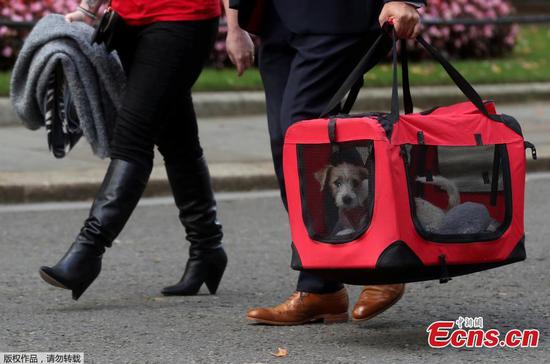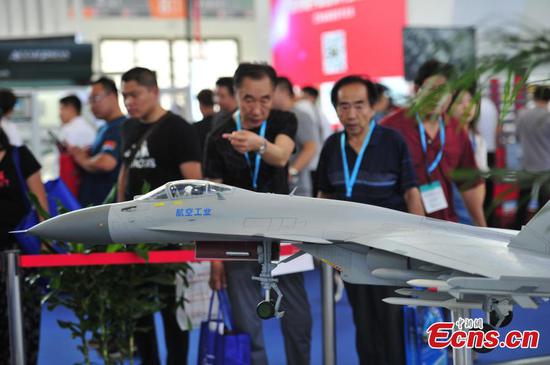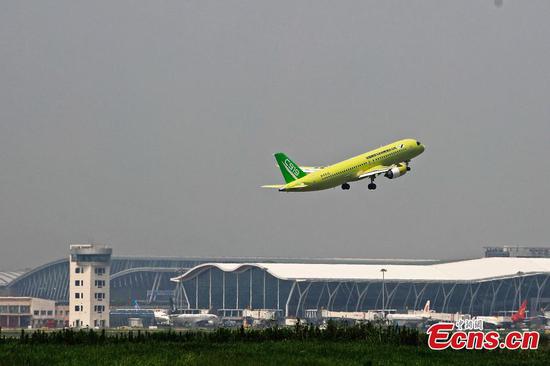
Airport employees hold a simulation drill in the departure lounge of the Beijing Daxing International Airport. (Photo by Chen Zebing / China Daily)
New airport in Beijing planning to enhance revenues with improved facilities, services
China's new $13 billion Beijing Daxing International Airport is expected to become a vital cog in global airport transfer passenger flows and improve Beijing's standing as a major global aviation hub, industry experts said.
With its centralized design and vertically stacked domestic and international departure halls, the Daxing airport will offer passengers more convenient and faster services for check-ins, transfers, security checks and baggage reclaim, said France-based ADP Ingenierie, the architectural designer of the airport.
Beijing has always been seen as a major transfer point for flights to the Americas and Europe. Out of the existing passenger flows at the Beijing Capital International Airport, nearly 20 percent is for departures and transfers from Beijing, indicating the huge potential.
International airports vie with each other to attract more transfer passengers as it brings in more revenue due to higher demand for catering services, duty-free shopping and other related services. From the administrative perspective, it generates more money via aircraft parking and other service usage fees.
On average, roughly 10,000 passengers transfer through the Beijing airport daily, according to data from Carnoc, a leading civil aviation website. The new airport, located 60 kilometers south of the city center, is expected to become China's largest integrated transportation hub and draw more international transfer passengers.
"The Daxing airport is more designed as a transfer airport. With a convenient layout, passengers need to walk only short distances for flight transfers, and could save more than an hour of transit time compared with the existing capital airport," said Lin Zhijie, an aviation industry analyst.
With its superior facilities, the Daxing airport will give Beijing the much-needed impetus to attract transfer passengers from Hong Kong, South Korea and Japan, US aircraft manufacturer Boeing Co said in a recent report.
"With growing capacity, carriers should consider how to raise their efficiencies at the two hubs and find ways to increase the proportion of transfer passengers," said Richard Wynne, managing director for regional marketing in China at Boeing Commercial Airplanes.
"A good connecting hub does not need to be in the middle of the country. Beijing has a good geographical location for international transfer passengers who fly from the Pacific and Europe," he said.
Indeed, that to some extent also explains why the major State-owned carriers are banking on the new airport to bolster their fortunes. China Eastern Airlines and China Southern Airlines, which currently have a market share of 12 percent and 13 percent in Beijing, are looking to improve it to 14 percent and 19 percent, after getting more slots at Daxing. The share of Air China will, however, fall from a dominant 43 percent to 42 percent, Boeing said.
The Beijing Capital International Airport is currently the second busiest airport globally after Hartsfield-Jackson Atlanta International Airport, and has been plagued by slot constraints. More than 50 domestic and foreign carriers have already evinced interest in operating flights from the Daxing airport.
A large number of cities own multiple airports globally, but not many have two large-scale comprehensive airports, except some cities such as London, New York, Bangkok and Shanghai. With Daxing, Beijing joins the list.
"The opportunities brought by the new airport will help Chinese carriers to increase their operating efficiencies and profits, and offset the rising costs of managing complicated schedules. For instance, London has six airports in the area, and British Airways has been one of the most profitable airlines globally," Wynne said.
Shanghai-based China Eastern said the opening of Daxing airport will be a historical growth opportunity for the carrier, and it will get more international flights rights in Beijing. By 2025, it is expected to account for 40 percent of the market share at Daxing airport.
"We will put 200 aircraft into operation at the new airport, with a total investment of more than 120 billion yuan ($16.7 billion), and launch more flights that connect China with the Americas, Europe, Oceania, Southeast Asia, South Korea and Japan," said Huang Pu, general manager of China Eastern Airlines' planning and coordination division in Beijing.
China Eastern is also applying for new international flight rights from Daxing airport to some major global metropolises. During the first quarter of this year, international flights contributed 31.7 percent of sales revenue to the company, it said.
Daxing airport has already started to sell some domestic and international flight tickets, and some of these are cheaper than the ones that operate on the same routes from the capital airport on the same day. A round-trip flight between Daxing airport and Helsinki in November would cost about 2,000 yuan cheaper than the same flight that departs from the capital airport.
"In the next few years, the capital airport will still be the first choice for business travelers. The price advantages of Daxing airport will attract more leisure and price-sensitive travelers," said Lin.
"In the short term, Daxing airport is likely to offer cheaper tickets than the capital airport to attract more passengers. Meanwhile, with increased overall capacity, ticket prices of the capital airport may go down as well, and passengers will be able to enjoy preferential tickets fares," he said.


















































